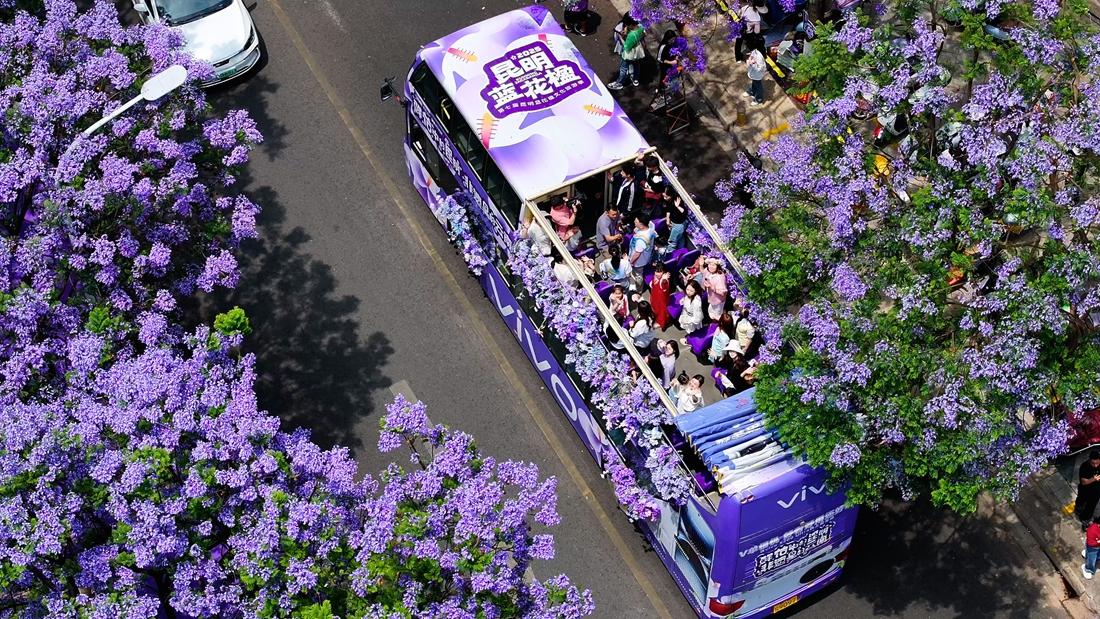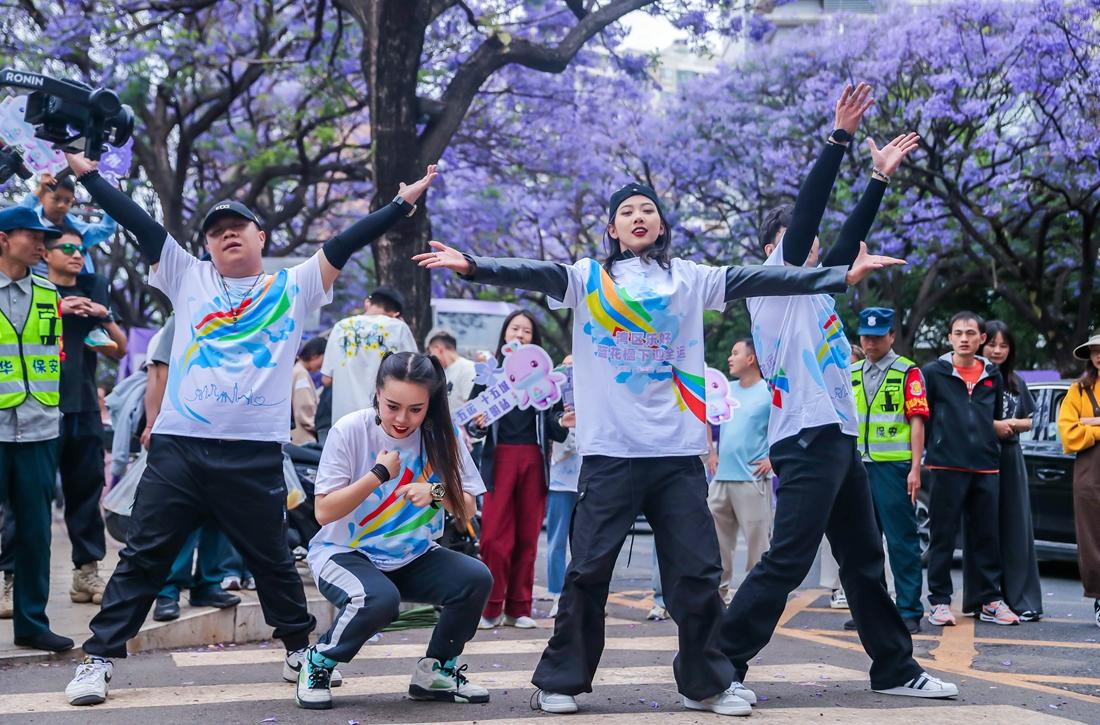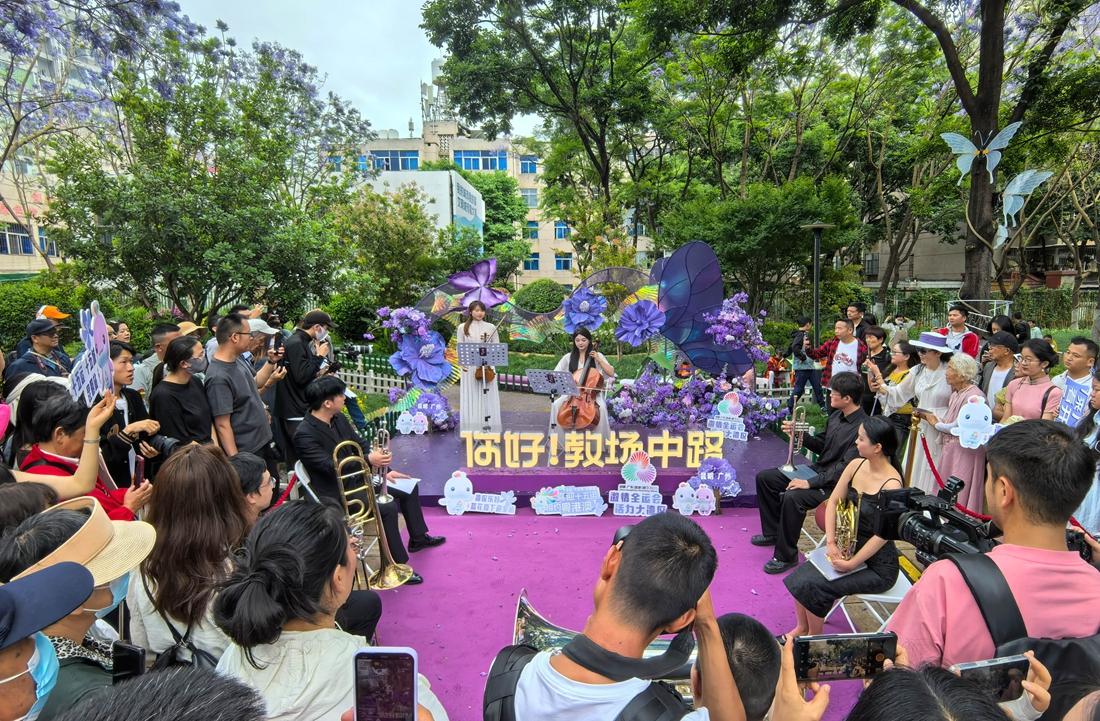Jacarandas bloom in Sino-Saudi cities, fueling cultural-tourist exchanges
When Chinese city Kunming at 25°N latitude basks in the bloom of jacarandas, the Saudi mountain city of Abha at 21°N also embraces the purple splendor.

Tourists take a jacaranda-viewing bus on Mid Jiaochang Road in Kunming, capital of southwest China’s Yunnan province, on May 10. Photo/Yunnan Daily
This cross-continental "jacaranda duo," spanning nearly 5,000 kilometers, weaves early summer romance into the 2025 China-Saudi Arabia Year of Culture.
In early May, Kunming, capital of southwest China’s Yunnan province, ushers in a purple spectacle, and the 2-kilometer Mid Jiaochang Road becomes a tunnel of indigo blossoms. With dreamy petals fluttering down to the street, the purple jacaranda is appealing to locals and travelers alike.
The jacaranda was first introduced into Kunming from Algeria in 1984, and the deed was done by botanists at the Kunming Institute of Botany, Chinese Academy of Sciences. After four decades of cultivation, these once-alien trees have blossomed into the city’s floral emblem.

The Abu Kheyal Park in Abha is flanked by jacaranda trees. Photo/Middle East Journeys
By 2024, over 20,000 jacarandas had been planted in urban Kunming, forming iconic "purple corridors" along Mid-Jiaochang Road, Panlong River banks, and other areas. Jacarandas light up the "spring city" in each May.
In 2019, the 1st Kunming Jacaranda Cultural Tourism Festival was launched on Mid-Jiaochang Road. The event featured floral admiration, cultural market, heritage displays, and art shows.
So far, seven editions of this event have been rolled out, inviting in over 3 million visitors who spent more than 200 million yuan on dining, shopping, and lodges in Kunming. The event shines as a name card of Kunming’s "floral economy."

Residents in central Yunnan's Kunming city usher in the jacaranda season on May 10. Photo/Yunnan Daily
In Abha, capital of Asir province in southwest Saudi Arabia, jacaranda trees have been planted in bulk in recent years, transforming this highland city into a signature hub of violet blooms.
Perched at 2,270 meters above sea level, Abha has a highest urban elevation in Saudi Arabia, and it enjoys a mild climate. The annual temperature averages at 18°C, and the rainfall is relatively abundant. These allow jacarandas to thrive.
Aligned with the Saudi green initiative by Crown Prince Mohammed bin Salman, the Asir provincial government has planted 25,000 additional jacarandas across Abha’s streets, cementing the tree’s role as a defining feature of urban landscape.

A resident in Abha enjoys leisure under jacaranda trees. Photo/Middle East Journeys
The Abha art street exemplifies the fusion of natural beauty and cultural vitality. Flanked by jacarandas, the street boasts colorful murals, landmark sculptures, and hanging umbrellas. At dusk, the lamps cast dreamy glows over the street, where art galleries, cafes, and restaurants invite locals and visitors to linger on and immerse themselves in the air of art.
In May’s gentle breezes, jacarandas in Kunming and Abha sway in unison.
Separated by vast distances yet united by similar latitudes, the two cities share a special bond out of jacarandas.

An event is staged in central Yunnan's Kunming city on May 10 for the jacaranda season. Photo/Yunnan Daily
As purple petals drift over the Dianchi Lake shores and the Jabal Sawda slopes, a new chapter of China-Saudi Arabia cultural exchange is quietly in creation—where jacarandas serve as a medium for dialogue.
By YICC reporters